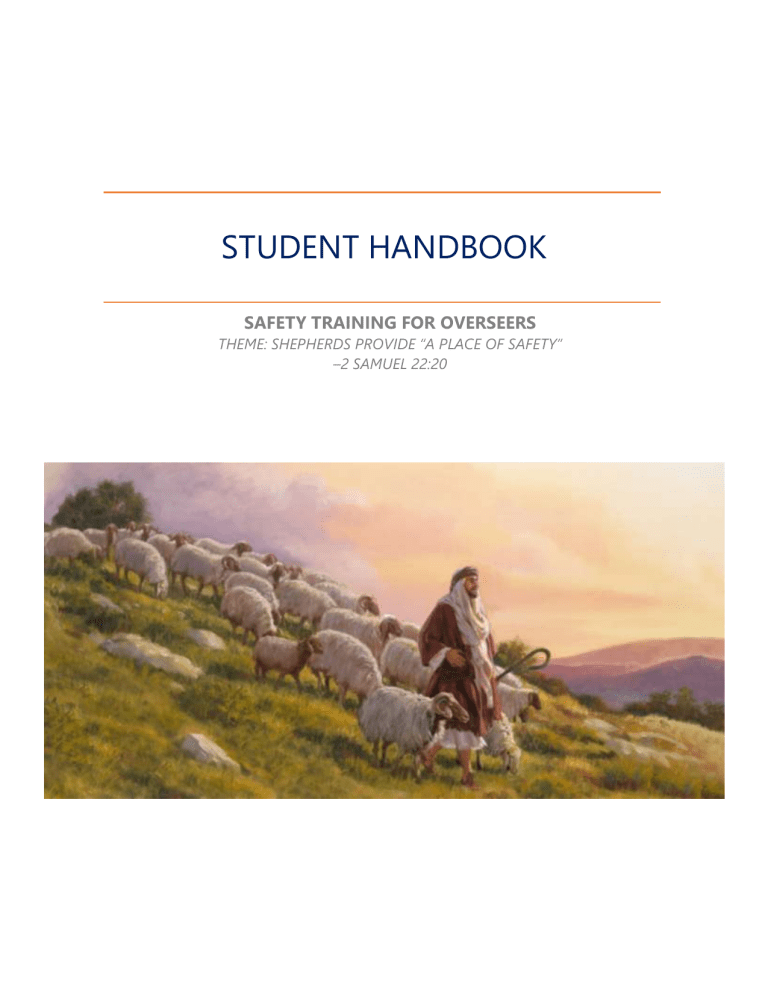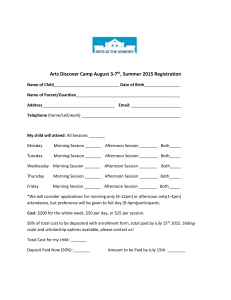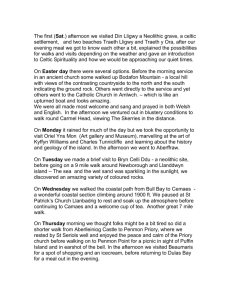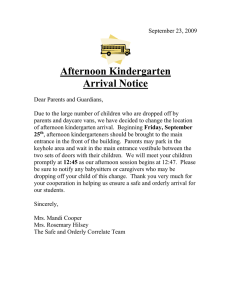
STUDENT HANDBOOK SAFETY TRAINING FOR OVERSEERS THEME: SHEPHERDS PROVIDE “A PLACE OF SAFETY” –2 SAMUEL 22:20 Review Questions Talk 2(Day 1 Morning) - Spirituality & Safety-Jehovah’s View of Life 1. How can we as overseers personally show that we have Jehovah’s view of life? Imitate Jehovah's view view by becoming imitators of him. Give Safety a Priority, Be principled minded. 2. How can overseers help others to have Jehovah’s view of life? Talk 3(Day 1 Morning) -An Accident Free Environment – Will Be Achieved 1. What ancient or modern examples prove that Jehovah can empower his people to achieve seemingly impossible goals? 1. Peter walked on Water without Sinking. 2. Examples of how the bible as been changing lifes in our publications. 3. The translation dept also did d impossible by translating our convention program 2. What are the keys to success in achieving this theocratic goal? If each one views safety as reflection of their personal relationship with Jehovah. Each individual must be firmly committed to the goal of an accident free environment. Targeting a zero accident goal. PRAYER is also vital for us. Talk 4(Day 1 Morning)- Your Role in Achieving an Accident Free Environment 1. What examples demonstrate the powerful effect overseers can have on others? 2. To a large degree, the success of achieving an accident free environment depends on who? Talk 6(Day 1 Morning) - Hazard / Risk Analysis 1. What two methods can be used to identify hazards? 2. Why should we perform Hazard / Risk Analysis throughout a project? Talk 7(Day 1 Morning) - Hierarchy of Controls 1. When should PPE be the only hazard control? 2. Why are elimination, substitution and engineering controls preferred over administrative controls and PPE? Talk 8(Day 1 Morning) - Identifying Hazards – Handling the Unknown 1. What 4 steps did Jehovah provide to help us handle the unknown? Talk 9(Day 1 Morning) Identifying Hazards – Visualizing the Consequences 1. How can we use visualization to avoid danger and create safe conditions? 2. How can we encourage others to develop skills of visualization? Talk 11(Day 1 Afternoon) - Job Hazard Analysis (JHA) 1. Why does the JHA process have to be imbedded in the planning phase of the project? 2. Why is it important to identify the person responsible for seeing that an “Eliminate or Control” method is carried out? Talk 13(Day 1 Afternoon) - Daily Safety Huddles 1. Why do we need daily safety huddles? 2. What are some key points to conducting effective daily huddles? Talk 16(Day 1 Afternoon) - Access Control 1. What are the three areas/zones on a project? 2. What are some steps that can be taken to reduce risk in higher risk areas? Talk 17(Day 1 Afternoon) - Project Safety Plan – What? Why? How? 1. What is a site safety and security plan? 2. Why is a site safety and security plan necessary? Talk 18(Day 1 Afternoon) - Food Safety 1. How can we prevent cross-contamination? 2. What is the danger zone? Talk 20(Day 2 Morning) - Spirituality & Safety – Our Brotherly Love 1. What are four areas where we can show love for our brother when it comes to safety? Talk 22(Day 2 Morning) - Effective Safety Investigations 1. What is a near miss and why should they be reported? 2. When should an accountability review be conducted? Talk 24(Day 2 Morning) - Maintain a Clean and Orderly Workplace 1. What are the scriptural reasons for maintaining a clean and orderly workplace? 2. What are some ways that we can maintain a clean and orderly workplace? Talk 25(Day 2 Morning) - Trenches & Excavation 1. What hazards may be encountered in and around trenches? 2. What controls can be utilized to mitigate the potential of hitting underground utilities? Talk 26(Day 2 Morning) - Hot Work Procedures & Fire Prevention 1. Before ever doing any type of hot work what should first be considered? 2. Why is it so important to carefully consider your choice of fire extinguishers when performing hot work? Talk 28(Day 2 Afternoon) - Remediation / Restoration 1. Why is source removal our usual method of remediation? Talk 29(Day 2 Afternoon) - Hearing Conservation 1. What factors must be considered when determining what type of hearing protection is needed? 2. In addition to PPE (i.e. ear plugs) how can we reduce or eliminate hearing hazards? 3. What key points do you remember for properly using: earplugs, earmuffs and pre-molded earplugs? Talk 30(Day 2 Afternoon) - Chemical Safety 1. How will knowing how to quickly access an SDS help you make wise decisions? Talk 31(Day 2 Afternoon) - Respiratory Protection 1. What are the two main types of contaminants that require respiratory protection? 2. When choosing the type of respiratory protection, what three elements of protection need to be considered and chosen? 3. Why is a fit-test required before wearing a respirator? Talk 32(Day 2 Afternoon) - Lockout/Tagout 1. What is lockout? 2. What are the lockout sequence steps? Talk 34(Day 3 Morning)- Spirituality & Safety – Our Christian Conscience 1. What is the role of the conscience? 2. How is the conscience connected to Safety? Talk 35(Day 3 Morning)- Confined Space 1. What constitutes a permit required confined space? 2. What is the only type of rescue permitted by anyone who is not part of a trained rescue team, and why? Talk 37(Day 3 Morning)-Interacting with Contractors 1. Why should we strive to interact with contractors in a loving and cautious way? 2. What did you learn that will help you prove cautious? Talk 39(Day 3 Afternoon)- Fall Protection 1. Why is an active fall arrest system so low in the hierarchy of controls for fall protection? 2. Why is it so important to incorporate “Rescue Planning” into work that involves using fall protection equipment? Talk 40(Day 3 Afternoon)- Supported Scaffold 1. When should a safety inspection be performed on a supported scaffold? 2. During the planning stages of a supported scaffold setup, what are some things we can ask ourselves? Talk 41(Day 3 Afternoon)- Aerial Lifts 1. Before operating an aerial lift, what should we do and why? 2. What good safety principles apply when operating a lift near pedestrians? Talk 42(Day 3 Afternoon)- As Fine Shepherds Put Safety in Its Place 1. What is the primary role of an overseer? 2. In what ways can show ourselves fine shepherds?


